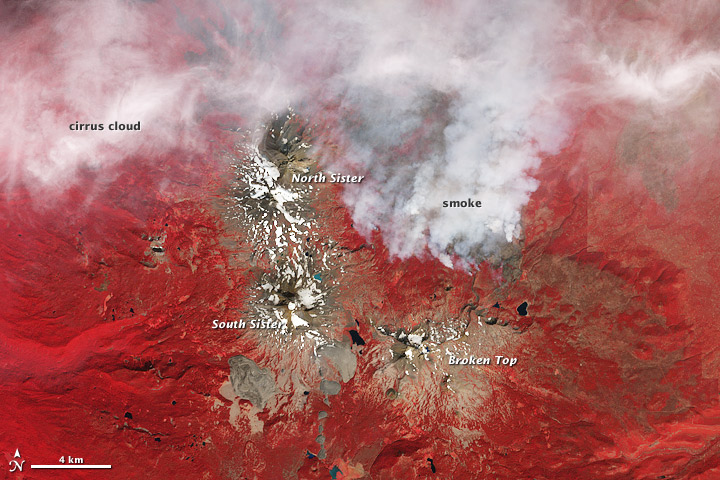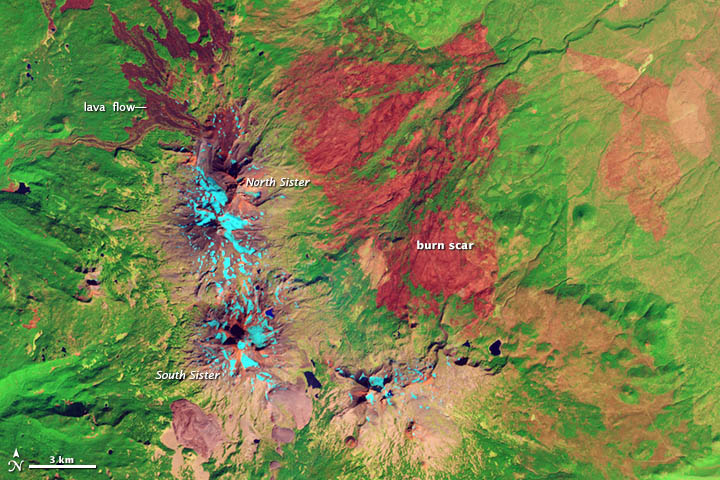The Pole Creek fire is hardly breaking news. As of October 20, 2012, authorities announced that the blaze was 100 percent contained. In early October, when we first published this image that the Terra satellite acquired in September, the fire was still burning wildly and sending up smoke plumes that shrouded the Three Sisters and the surrounding communities in a heavy layer of smoke.
A few weeks later, on October 5, a different instrument on a different satellite—the Advanced Land Imager (ALI) on NASA’s Earth Observing-1 satellite—acquired a false-color view of the fire (below). Rather than smoke billowing from an actively burning fire, the image features the burn scar left behind.
In ideal circumstances, we publish images of a fire while it is actively burning and also after the fact. But, in some cases, either because the satellites don’t acquire usable images or because we simply don’t have time to post them, we end up showing one view or the other.
There’s no shortage of fires we could show. (To get a sense of this, take a look at this map of global fire activity to see the constant presence of wildfires on our planet.) If we wanted, we could show only active fires with smoke, only burn scars, or any combination of the two and still have far more images than we could possibly post.
But which view do you prefer? And how late is too late? If a fire has been under control for day or weeks are you still interested in seeing the event or the scars that it left behind?
And what about other types of natural disasters like storms or volcanic eruptions? If a storm has already broken up, if a volcanic ash plume has dissipated, if a hurricane has no chance of making landfall…are you still interested in seeing it, or does it just feel like old news?






Burn plus afterburn photos are useful. Burn photos have PR impact. Afterburn photos are useful for soil and flood control planning.
Personally I’d use burn scar for emissions (although that’s the raw data), but in these articles it’s nice to see the how smoke moves.
I’d like to see both, similar to what is shown in this post. Active burns are informative for smoke dispersion and impacts, and burn scars after the fact would be show the extend of the burn area.
I’d also like to see both, but in one of your handy-dandy image comparison frames.
That would be useful. Smoke often obscures the extent of the fire.
If I HAD to pick I think the burn scars are more interesting. Smoke obscures things and after all, we all know where there’s fire, there’s smoke. The only interesting thing about smoke is seeing which way the wind is blowing and how dangerous the fire might be to areas in front of it.
The burn scars picture, with its false colors and clear info is more interesting to me.
For those of us who live in fire-prone rural areas, and are not involved in actual firefighting or research, any and all information is essential. There are also excellent fire-fighter sites that give this information day by day, and the combination of sites with varied information (photos, text, projections and discussions) gives enough coverage for individual and small town planning or evacuations.
I’d rather see the scars and aftermath photos. To me the hydrographic information is more relevent.
But which view do you prefer? And how late is too late? If a fire has been under control for day or weeks are you still interested in seeing the event or the scars that it left behind? Yes, interested.
And what about other types of natural disasters like storms or volcanic eruptions? If a storm has already broken up, if a volcanic ash plume has dissipated, if a hurricane has no chance of making landfall…are you still interested in seeing it, or does it just feel like old news? Yes, interested.